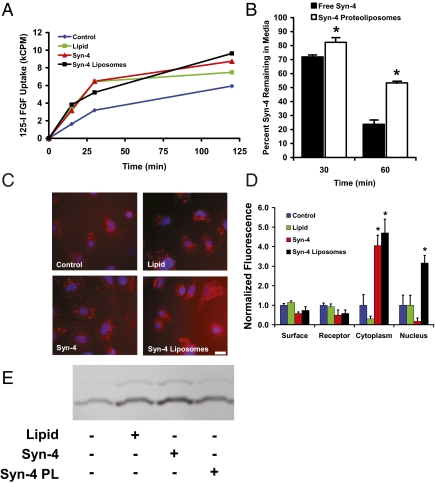Fig. 3.
Syndecan-4 proteoliposomes enhance FGF-2 uptake and intracellular trafficking. (A) Liposomally embedded syndecan-4 increases uptake of 125I-labeled FGF-2 in endothelial cells. FGF-2 alone (blue line), FGF-2 with liposomes (green line), FGF-2 with syndecan-4 (red line), and FGF-2 with syndecan-4 proteoliposomes (black line). (B) Liposome embedding prolongs 3H-labeled syndecan-4 presence in the media after 30 or 60 min. Syndecan-4 alone is shown with black bars, and syndecan-4 proteoliposomes are shown with white bars. (C) Uptake of fluorescently labeled FGF-2 is increased with syndecan-4 proteoliposomes. FGF-2 was labeled with Texas Red dye and added to cultures of endothelial cells for 4 h. (Scale bar, 20 μm.) (D) Nuclear localization of FGF-2 is increased in the presence of syndecan-4 proteoliposomes. Endothelial cells were exposed to fluorescently labeled FGF-2 for 4 h. The cells were then fractionated and the fluorescence in each fraction was measured and corrected for autofluorescence. (E) Lipids, syndecan-4, and syndecan-4 proteoliposomes enhance rac-1 activity. Cells were treated with various compounds and subjected to a pull-down assay for the active GTP-bound form of Rac-1.

